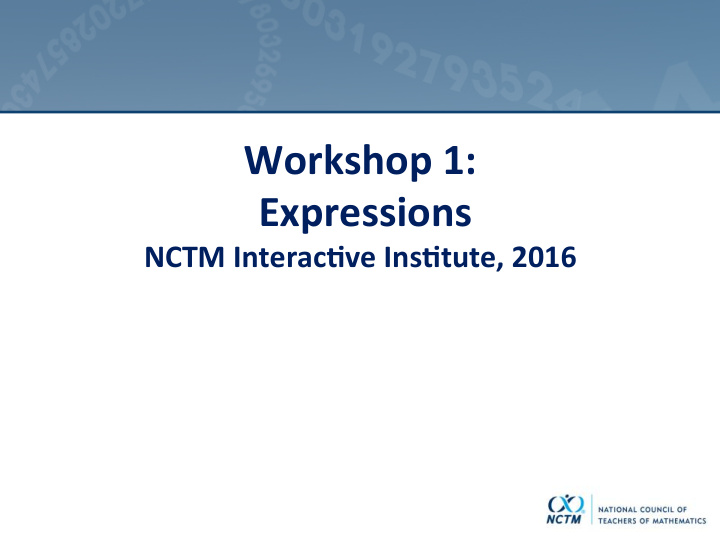



Workshop 1: Expressions NCTM Interac8ve Ins8tute, 2016
Introduc8ons Introduce yourself to others at your table: – Name – Where do you teach? – What grades/classes do you teach? – How long have you been teaching?
Introduc8on That’s Me AcAvity 3
That’s Me! • ACended NCTM Annual MeeAng 2016 in San Francisco? • ACended NCTM Regional anywhere in USA during 2015-2016? • ACended Algebra InsAtute in San Diego in 2014? • ACended Algebra InsAtute in Chicago in 2015? 4
That’s Me! • Are wearing shirt with pockets? • Are wearing flip-flops? • Wear glasses or contact lenses? 5
That’s Me! • Enjoy walking for exercise? • Enjoy running for exercise? • Enjoy watching others exercise and count it as your own exercise? 6
That’s Me! • Have an Ipad or Kindle Fire? • Speaks a second language? • Has a phone or other electronic device in their hand right now ? • Has an Apple watch? 7
That’s Me! • Saw a movie last weekend in a theater? • Read a book for pleasure in the past month? 8
That’s Me! • Have two brothers or sisters? • Have two children? 9
That’s Me! • Will be a first year teacher this upcoming school year? • Will be teaching a different grade next school year than last school year? 10
That’s Me! • Prefer students to be seated in rows on the first day of school? • Prefer students to be seated in small groups on the first day of school? 11
Common Core Standards This session will address the following: 6.EE.2 Write, read, and evaluate expressions in which leCers stand for numbers. 6.EE.4 IdenAfy when two expressions are equivalent. 6.EE.9 Write an equaAon to express one quanAty (dependent variable) in terms of the other quanAty (independent variable). 12
Staircase Problem
Staircase Problem In your pair, use a variable to write 2 different ways to describe your generalization.
Staircase Problem Share your expressions with your table.
Staircase Problem: Student Work 1 Think-pair-share: Describe the student’s thinking from this work.
Staircase Problem: Video (SW 2) hCps://youtu.be/9Ckqz0l0gDA 17
Discussion: Staircase Problem Video • How would you describe this strategy? • What type of thinking is evidenced in the video? 18
Staircase Problem: Reflec8on What strategies do you see when your students work this classic problem? How do these strategies demonstrate understanding of explicit or recursive thinking? 19
Recursive and Explicit Rules • In a recursive rule , each term is defined as a function of its preceding term(s). • An explicit rule designates each term as an expression of its location within the sequence. 20
Recursive to Explicit Thinking Recursive or Explicit Rules • Connect the change that occurred from one figure to the next in a recursive manner. • Use recursive model to write an explicit expression. • Simplify expression.
Student Performance: Zany Zs Student Performance How do you think 4 th , 8 th , and 12 th graders would do on a task like this? Talk about it at your tables. 22
Student Performance 8 th grade, on a similar item: 7.4% correct 12 th grade: 19.54% correct 23
Variables • In the Staircase Problem, you used a variable. • At your table, describe different ways that we can think about a variable. In general, what can it represent? 24
Use of Variable • Variables have many different meanings, depending on context and purpose. • Using variables permits wriAng expressions whose values are not known or vary under different circumstances. • Using variables permits represenAng varying quanAAes. This use of variables is parAcularly important in studying relaAonships between varying quanAAes. ( Developing Essential Understandings of Expressions, Equations, and Functions, 6– 25 8, [NCTM 2011], p. 9)
Use of a variable • When you think about your curriculum materials, what is the most ofen used role of a variable? • How does that impact student understanding of variable? 26
How would students respond? Bart said, “ t + 3 is less than 5 + t .” Always true SomeAmes true Never true Explain your answer. Cupcakes cost c cents each and doughnuts cost d cents each. I buy 4 cupcakes and 3 doughnuts. What does 4 c + 3 d stand for or represent? Dougherty, B. J., Foegen, A., Deleeuw, W., Olson, J. (2013). Progess monitoring tools: conceptual. Ames, IA: Iowa State University, University of Missouri . 27
Reflec8on Individual wri8ng – Pair discussion In the Staircase Problem, • What was the role of the teacher (instructor)? • What was the role of the student?
Reflec8on ( Principles to Actions: Ensuring Mathematical Success for All [NCTM 2014], p. 29)
Disclaimer The National Council of Teachers of Mathematics is a public voice of mathematics education, providing vision, leadership, and professional development to support teachers in ensuring equitable mathematics learning of the highest quality for all students. NCTM ’ s Institutes, an official professional development offering of the National Council of Teachers of Mathematics, supports the improvement of pre-K-6 mathematics education by serving as a resource for teachers so as to provide more and better mathematics for all students. It is a forum for the exchange of mathematics ideas, activities, and pedagogical strategies, and for sharing and interpreting research. The Institutes presented by the Council present a variety of viewpoints. The views expressed or implied in the Institutes, unless otherwise noted, should not be interpreted as official positions of the Council. 30
31
Recommend
More recommend